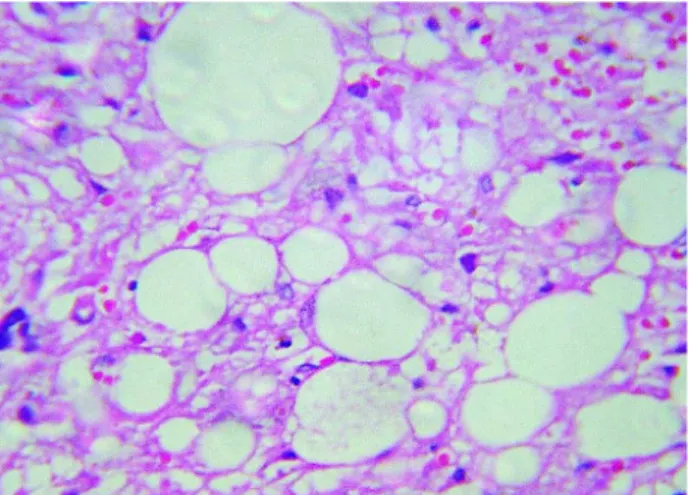214
RENAL LIPOSARCOMA Case Report
International Braz J Urol
Official Journal of the Brazilian Society of Urology
Vol. 30 (3): 214-215, May - June, 2004
RENAL LIPOSARCOMA
DIOGO A.L. BADER, LUIS A.B. PERES, SÉRGIO L. BADER
West Paraná State University, UNIOESTE, Cascavel, Paraná, Brazil
ABSTRACT
Introduction: Liposarcoma is a malignant mesenchymal tumor frequently located in retroperitoneum, and rarely presenting an isolated lesion in kidney.
Case Report: Female, Caucasian, 49-year old patient, with family history of renal polycystic disease, was selected for organ donation. During preoperative examinations a renal pleomorphic li-posarcoma was detected. She was treated with radical nephrectomy and remains asymptomatic, with-out evidences of recurrence in control ecographic examinations after a 4-year follow-up.
Comments: Renal liposarcoma is a rare tumor. We report one case incidentally diagnosed during a routine pre-transplantation assessment in renal donor.
Key words: kidney; kidney neoplasms; liposarcoma Int Braz J Urol. 2004; 30: 214-5
INTRODUCTION
Liposarcoma is a malignant mesenchymal tumor frequently located in the retroperitoneum (1). Isolated lesion in kidney has rarely been described (2). We present a case of renal liposarcoma inciden-tally diagnosed during the assessment of a candidate to renal donation for transplantation.
CASE REPORT
Female, Caucasian, 49-year old patient, with family history of renal polycystic disease, was se-lected for organ donation. During preoperative ex-amination a rounded, heterogeneous, well-defined mass with solid aspect was detected by renal ultra-sonography, adjacent to the lower pole of the left kid-ney. A computerized tomography was performed, showing an expansive, solid, heterogeneous lesion with -38 UH attenuation, poorly defined in the lower third’s external edge, measuring 3.8 x 3.8 cm and with preservation of perirenal fat. There was no contrast medium impregnation in the tumoral lesion during
the late phase (Figure-1). The angiography showed a hypovascularized and hypodense mass. The intrave-nous urography was normal. Radical nephrectomy was performed following the intraoperative freezing diagnosis of malignant lesion. The pathological ex-amination revealed a brownish nodular structure with 4.8 cm in diameter, and the microscopy detected neo-plastic tissue of mesenchymal origin, spindle and oval cells with abundant cytoplasm, hyperchromic nuclei and intense pleomorphism (Figure-2), characteristic of a renal pleomorphic liposarcoma. The patient has been followed up for 4 years and remains asymptom-atic, without evidence of recurrence on control ecographic examinations.
COMMENTS
215
RENAL LIPOSARCOMA
and presenting symptoms such as pain, hematuria, abdominal mass or loss of weight. The liposarcoma is classified according to the histological type, in well-differentiated, myxoid and pleomorphic. The myxoid type occurs in 60%, the well-differentiated in 25% and the pleomorphic in 10% of the cases. The pleo-morphic type is highly aggressive with high rates of metastases (2). We describe an incidentaloma of the pleomorphic type with 4.8 cm in diameter.
Perirenal localization is often observed in such tumors, which can mimic renal cystic tumor. The differential diagnosis must include renal cell carci-noma or atypical angiomyolipoma. Some features in the computerized tomography, such as linear vascu-larization, aneurismal dilatation, hematoma and pres-ence of tissue with fat attenuation speak for angiomyolipoma. Frequently the definitive diagno-sis is achieved only through the pathologic examina-tion (3).
The prognosis of liposarcomas depends on the degree of differentiation, size, histological type and tumor staging. The total surgical resection with free margins offers a good probability of cure (2). The standard treatment has been radical nephrectomy, associated or not with radiotherapy. Clinical follow-up is important to monitor tumor recurrence. There is a report of recurrence 13 years after the initial sur-gery (2). The case we described here was treated with
radical nephrectomy, presenting a 4-year follow-up, without evidence of recurrence to this moment.
Dr. José R. L. Ferreira and Dr. Alexandre Galvão Bueno assisted in preparing the images and the histological material.
REFERENCES
1. Lopes RI, Lopes RN, Filho B: Giant retroperitoneal liposarcoma. Int Braz J Urol. 2002; 28: 227-9. 2. Mayes DC, Fechner RE, Gillenwater JY: Liposarcoma
renal. Amer J Surg Pathol. 1990; 14: 268-73. 3. Wang LJ, Wong YC, Chen CJ, See LC: Computerized
tomography characteristics that differentiate angiomyolipomas from liposarcomas in the perinephric space. J Urol. 2002; 167: 490-3.
Received: September 29, 2003 Accepted after revision: January 21, 2004
Correspondence address: Dr. Diogo Alberto Lopes Bader Praça Getúlio Vargas, 55 / 10 Cascavel, PR, 85801-220, Brazil E-mail: diogobader@hotmail.com Figure 1 – The computerized tomography shows an expansive,
solid, heterogeneous lesion with -38 UH attenuation, poorly de-fined, in the external edge of the left kidney’s lower third, mea-suring 3.8 x 3.8 cm and with preservation of perirenal fat.
